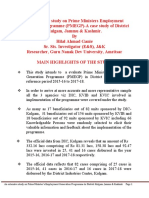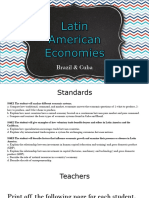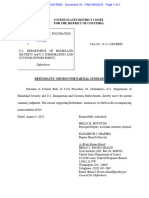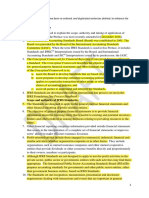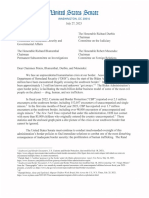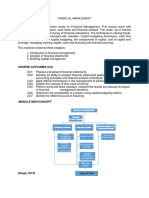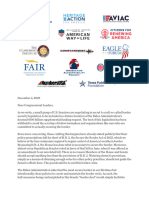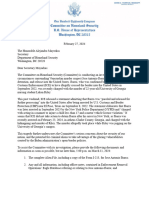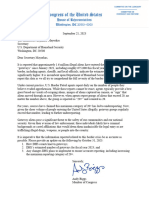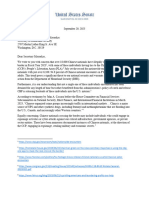0 ratings0% found this document useful (0 votes)
248K views2 pagesGallego Letter To Mayorkas On Pima County
The Congressman wrote to the Secretary of Homeland Security to request clarification about over $5 million in previously obligated emergency food and shelter funds designated for Pima County, Arizona. Pima County had requested an extension to use the remaining funds but was denied. Without the funds, Pima County will have to use new shelter and services program allocations earlier than projected, potentially leading to service disruptions. The Congressman asked the Secretary to reconsider or provide details on how the $5.2 million in remaining funds would be used, as arrivals and costs for assisting migrants have increased significantly.
Uploaded by
Fox NewsCopyright
© © All Rights Reserved
We take content rights seriously. If you suspect this is your content, claim it here.
Available Formats
Download as PDF, TXT or read online on Scribd
0 ratings0% found this document useful (0 votes)
248K views2 pagesGallego Letter To Mayorkas On Pima County
The Congressman wrote to the Secretary of Homeland Security to request clarification about over $5 million in previously obligated emergency food and shelter funds designated for Pima County, Arizona. Pima County had requested an extension to use the remaining funds but was denied. Without the funds, Pima County will have to use new shelter and services program allocations earlier than projected, potentially leading to service disruptions. The Congressman asked the Secretary to reconsider or provide details on how the $5.2 million in remaining funds would be used, as arrivals and costs for assisting migrants have increased significantly.
Uploaded by
Fox NewsCopyright
© © All Rights Reserved
We take content rights seriously. If you suspect this is your content, claim it here.
Available Formats
Download as PDF, TXT or read online on Scribd
You are on page 1/ 2
December 14, 2023
The Honorable Alejandro Mayorkas
Secretary
Department of Homeland Security
Washington, D.C. 20016
Dear Secretary Mayorkas:
I request that your agency immediately provide clarification about the whereabouts and
permitted uses of over $5 million in previously obligated funds that were designated for Pima
County, Arizona through the Emergency Food and Shelter Program- Humanitarian Phase HR22.
The county has been informed that they were denied an extension for the use of these funds. At a
time of increased arrivals to the border, this funding is crucial, and this lack of transparency is
unacceptable.
As you know, throughout this year, the Emergency Food and Shelter Program- Humanitarian
(ESFP-H) has been phased out and replaced by the Shelter and Services Program (SSP). During
this transition period, local governments and nonprofits that serve migrant populations have
continued to spend down the money they were previously awarded under EFSP-H.
Unfortunately, as I have written to you in the past, SSP has been underfunded in its first year and
its limited resources have been largely diverted away from the border. As a result, responsible
stewards of federal funding across Arizona have worked tirelessly to make their existing funding
last as long and go as far as possible. This has included using ESFP-H funding, sometimes past
the intended window of use, to make services available for as long as possible and postpone
funding cliffs created by inaction in Congress.
I recently heard from Pima County, who also serves as the fiscal agent for Santa Cruz County
and Cochise County, that their request for an extension of the period in which they can spend
their remaining ESFP-H funds was denied- for a second time. Their remaining HR22 award
balance of $5,216,146.91 would be instrumental in addressing the escalating number of asylum
seekers released into Arizona in recent months and preventing the collapse of Southwest Border
Coalition operations. Without this funding, Pima County will be forced to begin spending SSP
allocations to avoid revenue deficits, leading to a far earlier fiscal cliff than initially projected- as
soon as March of 2024.
As you know, the number of asylum seekers arriving in Arizona has risen in recent months:
according to Pima County’s own data, their monthly average of asylum seekers served has
increased from 7,142 in 2022 to 14,816 in 2023. The increasing number of migrants arriving in
the Tucson sector has also resulted in surging costs. For example, Pima County’s monthly costs
to serve asylum seekers increased from $2,779,891.88 to $3,983,396.16 (a 43.29% increase)
between June and October 2023, using the most cost-efficient practices. Costs for food have
increased by 293% and costs for transportation have increased by 95% in that same window.
Pima County has successfully managed over $65 million in ESFP-H awards in the last four
years, and was so trusted by FEMA that they were asked to serve as the fiscal agent for other
entities in the Tucson area. To pivot from entrusting Pima County with significant funds and
grant management responsibilities to ignoring their requests for how to spend their own money is
inconsistent and requires explanation. If EFSP board is unwilling to reconsider their decision, I
also request a full detail of where Pima County’s remaining $5,216,146.91 will go and how it
will be used. This Congressionally provided and Congressionally mandated funding must be
accounted for.
As Arizona faces looming fiscal cliffs and increasing risks of street releases under both the
EFSP-H and SSP programs, I will continue to follow up to request insight into these decision-
making processes.
Sincerely,
Ruben Gallego
MEMBER OF CONGRESS
You might also like
- BERF Ethiopia Foreign Exchange For BusinessesNo ratings yetBERF Ethiopia Foreign Exchange For Businesses83 pages
- RAFC ExeCom and Sectoral Committee OfficersNo ratings yetRAFC ExeCom and Sectoral Committee Officers2 pages
- Tarun Anhad JOAN R DEEPAK-1820354 SAKSHI - 1820342 Pulkit Pranav SaifNo ratings yetTarun Anhad JOAN R DEEPAK-1820354 SAKSHI - 1820342 Pulkit Pranav Saif17 pages
- Statistic - Id320776 - Contribution of Indian It BPM Industry To GDP of India Fy 2009 2025No ratings yetStatistic - Id320776 - Contribution of Indian It BPM Industry To GDP of India Fy 2009 20251 page
- The Halting Academic Liaisons To (HALT) Our Adversaries Act.No ratings yetThe Halting Academic Liaisons To (HALT) Our Adversaries Act.4 pages
- Nism Ii B - Registrar - Practice Test 22No ratings yetNism Ii B - Registrar - Practice Test 2219 pages
- Passport Issuance Reform and Backlog Elimination ActNo ratings yetPassport Issuance Reform and Backlog Elimination Act22 pages
- C) Fixed Rates Are Inherently Inflationary in That They Require The Country To Follow Loose Monetary and Fiscal PoliciesNo ratings yetC) Fixed Rates Are Inherently Inflationary in That They Require The Country To Follow Loose Monetary and Fiscal Policies4 pages
- Senate GOP Letter Re Oversight of Human TraffickingNo ratings yetSenate GOP Letter Re Oversight of Human Trafficking6 pages
- Banks, Duncan Letter On Visas For Foreign Nationals Who Back Hamas100% (1)Banks, Duncan Letter On Visas For Foreign Nationals Who Back Hamas5 pages
- Marshall Bill On Terror Watchlist EncountersNo ratings yetMarshall Bill On Terror Watchlist Encounters4 pages
- Letter To Blinken On Foreign Terrorism at BorderNo ratings yetLetter To Blinken On Foreign Terrorism at Border5 pages
- Governors To President Biden On Border Crisis ImpactNo ratings yetGovernors To President Biden On Border Crisis Impact3 pages
- Governors To President Biden On Impact of Border Crisis.100% (1)Governors To President Biden On Impact of Border Crisis.3 pages
- Homeland Committee GOP To DHS On Jose Ibarra100% (1)Homeland Committee GOP To DHS On Jose Ibarra2 pages
- M1515-MAI-MCL-MIR-0048 (Material Inspection Request)No ratings yetM1515-MAI-MCL-MIR-0048 (Material Inspection Request)2 pages
- Session Mai 2013: Examen National Du Brevet de Technicien SupérieurNo ratings yetSession Mai 2013: Examen National Du Brevet de Technicien Supérieur6 pages
- Letter To DHS On Chinese Nationals at The BorderNo ratings yetLetter To DHS On Chinese Nationals at The Border2 pages


